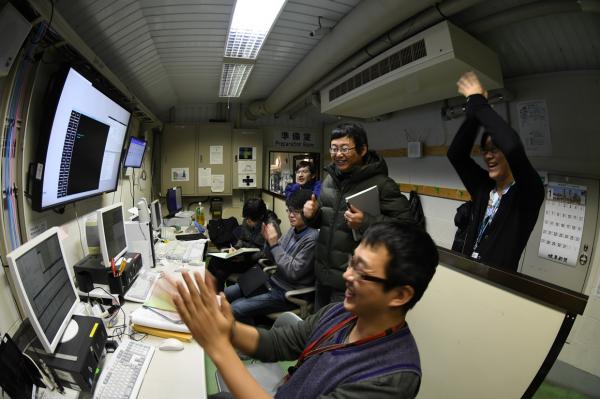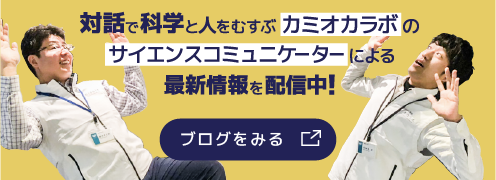Interview with Yumiko Takenaga about KamiokaLab
Cosmic Ray Research, The University of Tokyo
Yumiko Takenaga
For those who wish to know more about Astro Physics and Chemistry in Kamiokacho, I conducted an interview with Yumiko Takenaga, who is a publicist at Kamioka Observatory, Institute of Cosmic Ray Research, University of Tokyo, where experiments are performed using Super-Kamiokande.

What kind of device is the Super-Kamiokande?
Super-Kamiokande is a device that observes neutrinos, which are subatomic particles that travel to Earth from space. We can label matter around us using several words: elements, atoms, atomic nuclei, protons, and electrons. An element which can’t be divided into smaller parts is called an “elementary particle,” and a neutrino is one of these. The size of a neutrino is incredibly small; one ten hundred millionth of one ten hundred millionth of one ten hundred millionth of the size of a human. They have almost no weight. If we imagine an electron weighing as much as an elephant, a neutrino would weigh less than a 1 yen coin.
I see! If that’s the case, how do you observe neutrinos with the Super-Kamiokande?

The Super-Kamiokande is located 1,000 meters underground in Ikenoyama, Kamiokacho. Its approximate dimensions are 39 meters long and 41 meters tall. It’s a cylindrical tank with approximately 11,000 photo sensors inside. The tank contains extremely pure water, and when it detects a neutrino the photo sensors react. The volume of light recorded shows us the type of neutrino, its direction, and how much energy it has.

((c) Kamioka Observatory, ICRR(Institute for Cosmic Ray Research, The University of Tokyo)
Why are you able to observe neutrinos despite being 1,000 meters underground?
Neutrinos can pass through massive objects without interacting with them because they are neutral particles, holding neither a positive nor negative charge. Most matter has electrons which cannot pass through solid materials whereas neutrinos can.
Does that mean that neutrinos pass through Ikenoyama and reach the underground device?
Yes. Neutrinos pass through not only Ikenoyama, but also our bodies. They are so tiny you can’t see them, but hundreds of trillions of neutrinos pass through us every second.
How do you observe such small neutrinos with the Super-Kamikande?
Neutrinos pass through everything easily, but sometimes they hit water molecules. At that time, the photo sensor inside of tank will catch the light, called Cherenkov radiation. Out of the hundreds of trillions of neutrinos that pass through the water every second, only 30 neutrinos can be observed daily by the Super-Kamiokande photo sensors. To raise the probability of collission, we are trying to develop the Hyper-Kamiokande. It is much bigger than the current Super-Kamiokande, which stores 50,000 tons of water. The numbers of photo sensors are the same, but Hyper-Kamiokande tank is 260,000 tons, with 190,000 tons being used for analysis. This gives approximately 10 times more data than the Super-Kamiokande. As the volume of water increases, the number of times neutrinos hit water molecules increases. Therefore, we can observe more neutrinos in the Hyper-Kamiokande.

((c) Kamioka Observatory, ICRR(Institute for Cosmic Ray Research, The University of Tokyo)
What do you learn from observing neutrinos?
There are three types of neutrinos observed at Super-Kamiokande. The first one is a solar neutrino. This is a neutrino produced by reactions occurring inside of the sun with many of them flying around the earth. We can find out what goes on inside of the sun by observing solar neutrinos. The second one is an atmospheric neutrino. They are produced when particles traveling through space hit the atmosphere of the earth. By studying this, Nobel Prize winning Dr. Takaaki Kajita found that neutrinos have mass and that neutrinos change forms when they travel towards the earth. This is called “Neutrino Oscillation”. The third, called artificial neutrinos, are artificially produced to study neutrino oscillations. They are made by the J-PARK accelerator, located in Tokai-mura in Ibaraki, and flown from there to our Super-Kamiokande. By studying these three neutrinos, we can unravel the origin of the cosmos.
How important are neutrinos for unraveling the mystery of the space? What was the purpose for making Super-Kamiokande in the mountain of Kamiokacho?

((c) Kamioka Observatory, ICRR(Institute for Cosmic Ray Research, The University of Tokyo)
There were various conditions ideal for our research in Ikenoyama. First is water. The Super-Kamiokande needs to be filled with 50,000 tons of pure water. There are is a large amount of water available from melting snow in the mountain. Impurities such ions or bacteria are removed to ensure the water we use is of the highest quality. Next is hard bedrock. Ikenoyama is made of hard bedrock called Hida-gneiss. Even though we have made a large cavity 1,000 meters underground, the stability of the bedrock protects the facility from collapse. Third, the technique for drilling was important. Since Ikenoyama used to be a mine, there were local companies with drilling techniques available.
I see that Ikenoyama met all of those conditions. Then, why the Super-Kamiokande was made in not above the ground, but underground?
On the earth, there is atomic nucleus such as cosmic rays and element particle besides of neutrino are flying in high energy. If we set experiment device above ground, it is hard to catch neutrino since these cosmic rays interfere. Cosmic rays does not reach 1,000 meters underground since it does not pass through hard bedrocks, but neutrino reaches there since it goes through everything easily. Therefore it is very effective to observe them underground.
Now I understand why it was built in Kamiokacho. What kind of research are you planning for the future?
((c) Kamioka Observatory, ICRR(Institute for Cosmic Ray Research, The University of Tokyo)
Super-Kamiokande was renovated last year. Going forward, we plan to measure the neutrinos emitted by supernova explosions at the birth of the universe. We are able to distinguish which neutrinos were emitted from these explosions by using Gadlinium in the Super Kamiokande tank. Catching the neutrinos that have existed in outer space since the origin of the universe teaches us about how stars were created and how all matter, including us, came to be.
We also conduct experiments on proton decay at the Super-Kamiokande. The matter in our bodies and everything around us is made up of atoms. There is an atomic nucleus in the center of an atom, and is comprised of neutrons and protons. We believe that all matter eventually decays because protons have a limited lifespan. We can study this lifespan by observing protons in the pure water in the Super-Kamiokande. This research can lead to an understanding about the lifespan of protons of the Earth and the universe.
I see that neutrinos are particles with infinite potential that could lead understating the origin future development of the universe. It could also advance the field of physics. We are looking forward to exciting results from the Super-Kamiokande.





